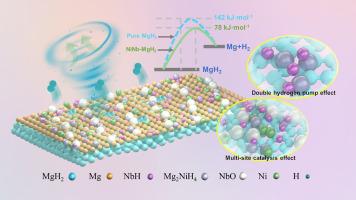当前位置:
X-MOL 学术
›
J. Magnes. Alloys
›
论文详情
Our official English website, www.x-mol.net, welcomes your
feedback! (Note: you will need to create a separate account there.)
Cation-induced topical disordered niobium nickel oxide for robust hydrogen storage in magnesium hydride
Journal of Magnesium and Alloys ( IF 15.8 ) Pub Date : 2024-11-09 , DOI: 10.1016/j.jma.2024.10.011 Shuai Li, Liuting Zhang, Fuying Wu, Qian Li
Journal of Magnesium and Alloys ( IF 15.8 ) Pub Date : 2024-11-09 , DOI: 10.1016/j.jma.2024.10.011 Shuai Li, Liuting Zhang, Fuying Wu, Qian Li

|
Catalytic doping is one of the economic and efficient strategies to optimize the operating temperature and kinetic behavior of magnesium hydride (MgH2). Herein, efficient regulation of electronic and structural rearrangements in niobium-rich nickel oxides was achieved through precise compositional design and niobium cation functionalized doping, thereby greatly enhancing its intrinsic catalytic activity in hydrogen storage systems. As the niobium concentration increased, the Ni-Nb catalysts transformed into a mixed state of multi-phase nanoparticles (composed of nickel and niobium-rich nickel oxides) with smaller particle size and uniform distribution, thus exposing more nucleation sites and diffusion channels at the MgH2/Mg interface. In addition, the additional generation of active Ni-Nb-O mixed phase induced numerous highly topical disordered and distorted crystalline, promoting the transfer and reorganization of H atoms. As a result, a stable and continuous multi-phase/component synergistic catalytic microenvironment could be constructed, exerting remarkable enhancement on MgH2's hydrogen storage performance. After comparative tests, Ni0.7Nb0.3-doped MgH2 presented the optimal low-temperature kinetics with a dehydrogenation activation energy of 78.8 kJ·mol−1. The onset dehydrogenation temperature of MgH2+10 wt% Ni0.7Nb0.3 was reduced to 198 °C and 6.18 wt% H2 could be released at 250 °C within 10 min. In addition, the dehydrogenated MgH2 NiNb composites absorbed 4.87 wt% H2 in 10 min at 125 °C and a capacity retention rate was maintained at 6.18 wt% even after 50 reaction cycles. In a word, our work supplies fresh insights for designing novel defective-state multiphase catalysts for hydrogen storage and other energy related field.
NiNb composites absorbed 4.87 wt% H2 in 10 min at 125 °C and a capacity retention rate was maintained at 6.18 wt% even after 50 reaction cycles. In a word, our work supplies fresh insights for designing novel defective-state multiphase catalysts for hydrogen storage and other energy related field.
中文翻译:

阳离子诱导的局部无序铌镍氧化物在氢化镁中实现稳健的储氢
催化掺杂是优化氢化镁 (MgH2) 工作温度和动力学行为的经济有效的策略之一。本文通过精确的成分设计和铌阳离子功能化掺杂实现了富铌镍氧化物中电子和结构重排的高效调控,从而大大增强了其在储氢系统中的本征催化活性。随着铌浓度的增加,Ni-Nb 催化剂转变为粒径更小且分布均匀的多相纳米颗粒(由镍和富铌镍氧化物组成)的混合状态,从而在 MgH2/Mg 界面处暴露出更多的成核位点和扩散通道。此外,活性 Ni-Nb-O 混合相的额外生成诱导了许多高度局部的无序和扭曲晶体,促进了 H 原子的转移和重组。结果,可以构建一个稳定连续的多相/组分协同催化微环境,显着增强 MgH2 的储氢性能。经过比较测试,Ni0.7Nb0.3 掺杂 MgH2 呈现最佳低温动力学,脱氢活化能为 78.8 kJ·mol-1。MgH2+10 wt% Ni0.7Nb0.3 的起始脱氢温度降低到 198 °C,在 250 °C 下 10 min 内可释放 6.18 wt% H2。此外,脱氢的 MgH2 NiNb 复合材料在 125 °C 下 10 min 内吸收了 4.87 wt% 的 H2,即使在 50 个反应循环后,容量保持率仍保持在 6.18 wt%。 总之,我们的工作为为储氢和其他能源相关领域设计新型缺陷态多相催化剂提供了新的见解。
NiNb 复合材料在 125 °C 下 10 min 内吸收了 4.87 wt% 的 H2,即使在 50 个反应循环后,容量保持率仍保持在 6.18 wt%。 总之,我们的工作为为储氢和其他能源相关领域设计新型缺陷态多相催化剂提供了新的见解。
更新日期:2024-11-09
 NiNb composites absorbed 4.87 wt% H2 in 10 min at 125 °C and a capacity retention rate was maintained at 6.18 wt% even after 50 reaction cycles. In a word, our work supplies fresh insights for designing novel defective-state multiphase catalysts for hydrogen storage and other energy related field.
NiNb composites absorbed 4.87 wt% H2 in 10 min at 125 °C and a capacity retention rate was maintained at 6.18 wt% even after 50 reaction cycles. In a word, our work supplies fresh insights for designing novel defective-state multiphase catalysts for hydrogen storage and other energy related field.
中文翻译:

阳离子诱导的局部无序铌镍氧化物在氢化镁中实现稳健的储氢
催化掺杂是优化氢化镁 (MgH2) 工作温度和动力学行为的经济有效的策略之一。本文通过精确的成分设计和铌阳离子功能化掺杂实现了富铌镍氧化物中电子和结构重排的高效调控,从而大大增强了其在储氢系统中的本征催化活性。随着铌浓度的增加,Ni-Nb 催化剂转变为粒径更小且分布均匀的多相纳米颗粒(由镍和富铌镍氧化物组成)的混合状态,从而在 MgH2/Mg 界面处暴露出更多的成核位点和扩散通道。此外,活性 Ni-Nb-O 混合相的额外生成诱导了许多高度局部的无序和扭曲晶体,促进了 H 原子的转移和重组。结果,可以构建一个稳定连续的多相/组分协同催化微环境,显着增强 MgH2 的储氢性能。经过比较测试,Ni0.7Nb0.3 掺杂 MgH2 呈现最佳低温动力学,脱氢活化能为 78.8 kJ·mol-1。MgH2+10 wt% Ni0.7Nb0.3 的起始脱氢温度降低到 198 °C,在 250 °C 下 10 min 内可释放 6.18 wt% H2。此外,脱氢的 MgH2






























 京公网安备 11010802027423号
京公网安备 11010802027423号